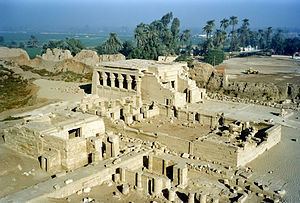Country Egypt Time zone EST (UTC+2) | Local time Monday 3:21 PM | |
 | ||
Weather 28°C, Wind NW at 11 km/h, 18% Humidity | ||
Dendera (Arabic: دندرة Dandarah; also spelled Denderah, ancient Iunet, Tentyris or Tentyra) is a small town and former bishopric in Egypt situated on the west bank of the Nile, about 5 kilometres (3 mi) south of Qena, on the opposite side of the river. It is located approximately 60 kilometres (37 mi) north of Luxor and remains a Latin Catholic titular see.
Contents
- Map of Dandarah Qena Egypt
- History
- Ecclesiastical History
- Titular see
- The temple complex
- Climate
- References
Map of Dandarah, Qena, Egypt
History
At a rather isolated place at the edge of the desert, about 2.5 kilometres (1.6 mi) south-west of the modern town, lies what Dendera is famous for, a mostly Greco-Roman temple complex known in ancient Egyptian as Iunet or Tantere. The modern Arab town is built on the ancient site of Ta-ynt-netert, which means 'She of the Divine Pillar.' In the Greek era, the town was known as Tentyra. It was once the -modest- capital of the 6th Nome (Pharaonic province) of Upper Egypt, and was also called Nikentori or Nitentori, which means 'willow wood' or 'willow earth'. Some scholars believe the name derives from the sky and fertility goddess Hathor, also associated with the Greek Aphrodite, who was especially worshiped there. The official deity of the city was a crocodile. Crocodiles were also venerated as deities in other Egyptian cities, which gave rise to many quarrels, notably with Ombos.
Ecclesiastical History
After Egypt became a Roman possession, the city of Tentyris was part of the Late Roman province of Thebais Secunda. Its bishopric was a suffragan of Ptolemais Hermiou, the capital and metropolitan see of the province. Little is known of the history of Christianity in the place, as only the names of two ancient bishops are given:
The town was given its present Arabic name of Denderah during the late Ottoman Empire and ruled 6000 inhabitants in Qena (Qeneh) district.
Titular see
Under the Latin name Tentyris, the episcopal see was nominally revived as a titular bishopric (in Curiate Italian repeatedly renamed) since 1902, but is vacant since 1972, having had the following incumbents of the fitting episcopal (lowest) rank :
The temple complex
The Dendera Temple complex, which contains the Temple of Hathor, is one of the best-preserved temples, if not the best-preserved one, in all of Upper Egypt. The whole complex covers some 40,000 square meters and is surrounded by a hefty mud brick wall. The present building dates back to the times of the Ptolemaic dynasty and was completed by the Roman emperor Tiberius, but it rests on the foundations of earlier buildings dating back at least as far as Khufu (known as the Great Pyramid builder Cheops, the second Pharaoh of the 4th dynasty [c. 2613–c. 2494 BC]).
It was once home to the celebrated Dendera zodiac, which is now displayed in the Louvre Museum in Paris. There are also Roman and pharaonic Mammisi (birth houses), ruins of a Coptic church and a small chapel dedicated to Isis, dating to the Roman or the Ptolemaic epoch. The area around the temple has been extensively landscaped and now has a modern visitor centre, bazaar and small cafeteria.
Climate
This area has a large amount of sunshine year round due to its stable descending air and high pressure. According to the Köppen Climate Classification system, Dendera has a hot desert climate, abbreviated "BWh" on climate maps.
